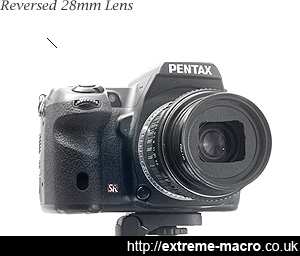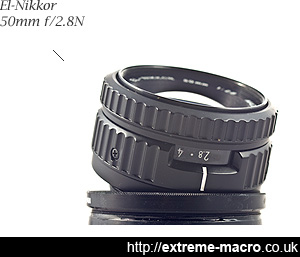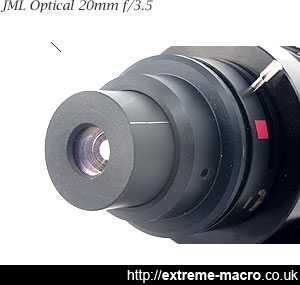Extreme Macro Lenses
by Johan J Ingles-Le Nobel
Last updated August 31, 2017
There is no such thing as the definitive guide to extreme macro lenses. Even if there were, it's probably already out of date as there are undiscovered gems out there waiting to be used for macro.
Once you go beyond 2:1, the 'must have' lens landscape changes periodically, and finding a relatively rare lens is largely a matter of word of mouth and trial and error. For example, the JML 21mm is horribly hard to find.
A reversed 28mm lens, a great way to do macro without even buying a macro lens. The crucial things to remember when starting out with reverse lens macro is that the brand doesn't matter (because it's reversed so you don't need to match the mount of your camera), and you want a lens with manual f/stops.
Extreme macro lenses come in all types, shapes and sizes and you should definitely be aware that there's a lot of adapter love involved. I have boxes of them. The fact is, for extreme macro we often use any lens regardless of its original application, so for example 35mm enlarger lenses, industrial machine vision lenses and microfiche lenses can and are all used.
Sample Variation
One thing to be aware of is that there is nearly always sample variation in lenses, not just the lenses themselves but if you purchase a used lens, how they were treated by the previous owner. So in the lenses that I present as 'good', these are my samples and this may not turn out the same as if you buy the same used or new lens - this is unavoidable. However, having said that, I'm not aware of unusual sample variation in these and many others have reported them as good.
Working Distance
The working distance of an extreme macro lens is the distance between subject and the front of the lens.
Regardless of whether you're outside in the field or in the studio doing your extreme macro, a comfortable working distance is one of the most important considerations.
Not merely in terms of approaching an insect outside in the field, but the indoor studio soon becomes cluttered so having a standoff is a good thing. This is especially so if you're using flash to light your subjects, because flash units are big and bulky and get in the way.
But there's more to working distance beyond distance to the subject:
Working Distance And Illumination
Another reason working distance matters is illumination and if you're angling a flash unit down to light your subject, the last thing
the working distance for microscope objectives is typically measured in parts of a mm
you want is little working distance. With a short working distance, either the lens hood
gets in the way of the flash or the angle of flash is so severe that it does not manage to reach down into the crevasses of your subject. This is a very common problem.
Working distance becomes a truly horrible problem once you start exploring beyond 10x, as the working distance for microscope objectives is typically measured in parts of a mm. This is why microscope objectives marked ELWD (extra long working distance) command a premium price, many times the price of the same objective with a small working distance.
Reversed Standard Lens
Many people's introduction to extreme macro starts by reversing a standard prime lens, either straight onto the camera body, using extension tubes or reversing onto another lens ("coupling").
You will need to buy the right adapter for this, and it is easier if done with a manual lens that has an aperture ring.
Reverse lenses yield good results and have the added benefit that it is cheap: your reversed lens does not need to be the same brand as your camera body so you can shop around.
Reversed Enlarger Lens
Nikon El-Nikkor 50mm f/2.8N, a cracking enlarger lens that performs beautifully. The Nikon El-Nikkor 50mm f/2.8N is a relatively low cost enlarger lens that's ideal for those just starting out in extreme macro. It can be used both for studio stacking and in the field.
Reversing an enlarger lens is often the next step up from reversing standard prime lenses.
Old enlarger lenses are especially good for extreme macro because they have both the resolution that you want and they're great at flat field photography.
Some are better than other though: look to find yourself a high quality premium six element enlarger lens design for better image quality and resolution.
Knowing which enlarger lenses to reject is also useful.
Microscope Objectives
Once you get down to about 5x, diffraction tends to kick in because you can't open your reversed enlarger lens any further.
Microscope objectives tend to be used beyond this point, in two variants: infinity objectives used in conjunction with extreme macro tube lenses and finite objectives used in conjunction with bellows.
The legendary JML Optical 21mm f/3.5. The JML Optical 21mm f/3.5 exhibits excellent correction of all aberrations for an angle of 35 degrees without vignetting. Its resolution in focus is 385 lines/mm when the image of object is in focus (D=6mm), or 500 lines/mm when object is in focus (numerical aperture 1.41).
Other Extreme Macro Lenses
No extreme macro lens discussion would be complete without mentioning Canon's Mp-e 65, an off the shelf lens that has a magnification range of 1:1 to 5:1.
Canon is the only big brand that really takes extreme macro seriously.
Beyond this, there are also specialist lens makes from which lenses can be repurposed to be used for extreme macro. For example, microfilm lenses, projector lenses and optics from industry companies such as JML Optical.
Related Articles






